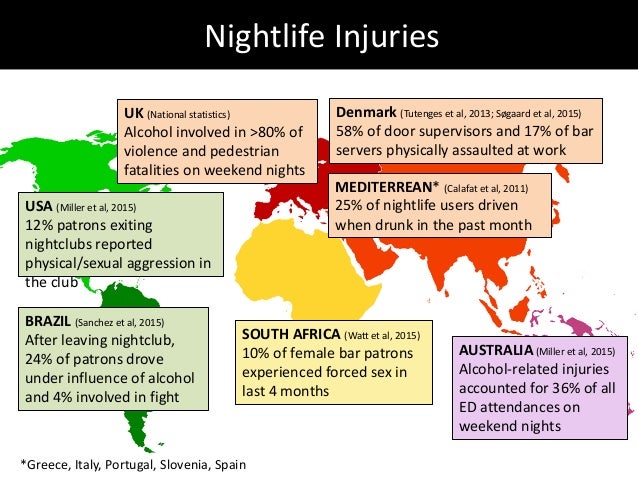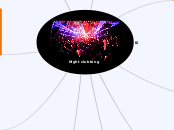
Night clubbing
Nowadays night clubbing has evolved from a rebel hobby to a massive economic activity that not only provides thousands of job opportunities (both partial or full time), but also can become the main industry of certain areas such as Ibiza.Being an IE student, I am sure everyone in this course has lived the famous Madrid "movida". This mindmap aims to show the different aspects we all think about when choosing where to go clubbing, together with the different experiences throughout the night.There is no ideal club, since there is no ideal party mindset, so feel free to comment any feature you missed while navigating the document...

Transportation
Transportation to (and even more from) the night club or party venue is one of the greatest pain points of the night.Several clubs are very distant from urban areas, which makes sense from the urbanism point of view so that less people gets disturbed. Even downtown clubs will be harder to reach once the public transportation system shuts down.The first thought might be taking your own vehicle. However, it would only be advisable in case you have one of those scarce and highly-appreciated friends who do not drink any alcohol. Even in that case, finding a parking slot can get hard.The most common transportation means, therefore, is taxi. The most crowded clubs will surely have a queue of taxis waiting for customers at the exit, and VTC (from french Voiture de Tourisme avec Chauffeur = Vehicle with driver) like Uber or Cabify cite alcohol as one of the main reasons to use them, as well as their contribution to society's wellbeing.As an special type of VTC we can list also limos or disco cars/buses...

A problem to solve
Bus party in Colombia (Chiva)
.jpg)
Queuing
Queuing is of great importance in night clubs: the entrance line is just the first of many.Cloak checks, drinks ordering, toilets, everything inside a crowded club is subject to queuing.Let's take a look at the queing theory from the point of view of a club customer:"Unoccupied time feels longer than occupied time". We usually wait with friends, so we can chat with them. As we learnt, "solo waiting feels longer than group waiting". Taking pictures, using cellphones or looking (and commenting) into other people in the queue are usual distractions."Pre-process waits feels longer than in-process waits". This is critical in the entrance queue, since we probably care less about the waiting time for drinks, even if all summed up could be a longer time."Anxiety makes waits seem longer". Linked to the previous point, the entrance queue of a night club must be one of the most anxious possible queues: you are frequently exposed to bad weather but above all you cannot be sure of being accepted in, a bad experience can be found at the end of the line due to a blurred right of admission policy."Uncertain waits are longer than known, finite waits". There is no known wait in a night club: sometimes the queue can be quiet for a long while, even if there are people leaving the club. Both the toilet queue and the drinks one are uncertain as well, since the barcrew do not follow a fixed order and club toilets witness much more than standard toilets..."Unexplained waits are longer than explained waits". We never know the reason why the queue is not progressing outside a club, and demanding an explanation might not be the best idea. Other club queues are easier to understand since you usually see what's happening at the end of the queue."Unfair waits are longer than equitable waits". One of the most painful points of clubs. You can be in line for ages and then a group of well-connected people might get inside skipping the queue or a cooler guy or girl might be served a drink before you without any justified reason. Pricing can be another source of unfairness but it will be mentioned at that slide."The more valuable the service, the more I could wait". This is an interesting topic in case of clubs, since sometimes the length of the queue contributes to increase the expectations of a new customer. The logic says that frequent customers will only wait a long time if they liked it on previous occasions.
Admission policy issues
Here is an example of admission polemics in a club in London.We all know there are unfair reasons for not being let inside a club. Looks, gender, social class...even the color of your skin can pose a threat to entrance in certain prestigious clubs...but we all implicitly accept it and we keep coming once and again...

How to skip lines

Security
Security is a concern for customers and a duty for club owners. However, such concern is not always paid the due attention, given that sometimes the consequences do not show up in the short term, and it costs money (and maybe tons of effort) to address. In that sense, it could be considered as a sort of "quality control". Likewise, it would be a mistake to consider it only an "expense" and not an "investment".Security staff should ensure that there are no fights inside the club (neither right at the door), that there is no drug-dealing inside, and that none is being molested by other customers. A bad customer experience due to this issue has high chances of causing a customer loss.Nonetheless, bad security staff can either create the problems themselves or increase them by overreacting.

Dealing with drug dealers

A worldwide problem
People just make wrong choices when drunk...
I posted this video as an example of stupid actions drunk people make.It was a big scandal in Spain after the aggresion happened on February 22nd, 2015. The drunk guy was dumb enough to post his "achievement" on youtube, so he was then traced by police and taken to court.The Fiscal has demanded a 3 year jail penalty and 45.000 euro as compensation for the woman, but the final resolution is still pending.All this to say that clubs and doormen also have to deal with such kind of people, and they must do it with care so as to not suffer from PR damages while still ensuring the security of the rest of customers.

Extra features
There are uncountable options to improve the customer experience with extra features in your club...just to name a few:Theme partiesCoat checkAlcohol metersValet parking servicesFood options

Food menus to help late hunger

Coat check suggestions
Definetely out of the ordinary
An example not only of theme party, but also of taking party home!

Pricing
Pricing is one of the main aspects for both customers and club owners. It is also one of the major generator of expectations.It is one of the main differentiation tools, as well as the key driver for the business model. A club offering open bar (all night or up to a certain time) should operate different than a club without such option. Plus, a club focused on college students will not charge the same Price as a club focused on white collars in their 30s, even if sometimes they offer the same objective product --> the experience they offer is not exactly the same!Moreover: does the club charge for entrance? Does it include a drink or not? Is there any discount provided by PR people? Will the club charge for extra services or will they be included?Will the club include a VIP area? If so...will it be at an increased entrance fee or with the condition of booking a table and purchasing an entire bottle?

Nighclub business models

Location
The first of our choices must be related to the location: where do we want to go partying? A close-by reachable club or a massive warehouse-like disco in the outskirts? A place with beutiful views from the terrace? A pool party? There are plenty of options, and this first decision will have a great influence in the following.
Best clubs in the world

If you are into views more than music

Music
Music is a requisite for clubs, and it is another tool for differentiation.On one hand, specialized clubs may offer jazz music, salsa, vintage classics, etc... in order to reach a very specific target audience. Certain music is required for customers willing to dance, as well as certain music might make it harder for customers interested in talking. On the other hand, massive discos broadcast top hits to address a customer base as broad as possible.Live concerts are a powerful means of creating Wow experiences, especially if they are not advertised.Some other clubs have star Dj's as part of their staff, or they hire them for special nights.As part of the music experience, a good lighting system can be added.
From a relaxing option...
...to a frenetic one

People
As a customer, the people inside the club is one of the main attractions when partying. Nonetheless, it is rarely known neither the quantity of people inside nor the demographics of that people.None wants to be the first one to enter an empty club, but a heavily-packed club where you can barely move is equally bothering.For the club itself, addressing the right customer demographics is one of the keys to success, as mentioned in the article attached.However, it is difficult to reject people at the door without solid reasons. Dress codes, guest lists and pricing are the easiest thresholds to implement. Private events, PR street offers or having reached maximum capacity can be helpful as well. There are considerably harder hurdles like being considered "too drunk" to enter or directly reject without justification.Rejecting one person within a big group of an homogeneous gender can be a means to keep the desired gender balance.Furthermore, there must be control inside the club for security purposes in order to avoid conflictive behaviors that, when mixed with alcohol, can easily scale up.

VIP area

To free, or not to free?

Drinks
Drinks are the main supply in a night club. They have a key property: long expiration date, which allows to have a stock as great as your financials and inventory room can afford. Running out of a type of liquor or even a brand can tarnish a club reputation. Running out of coke would be a colossal disaster.That being said, drinks can also become a differentiation point, especially in big cities. An original cocktail menu or a specialized gin counter can be an outstanding marketing asset, although they would mean a much longer preparation time as well.Apart from non-alcoholic cocktails, clubs do not like customers ordering non-alcoholic drinks. Soft drinks alone or water are charged a much higher margin than alcoholic drinks, so as to compensate those orders.I would also like to mention that some clubs use re-filling techniques, selling poorer alcohol to customers to increase profits, at the expense of a bad customer experience (which does not finish when leaving the club...)
Gin&tonic preparation

Example of distribution network
